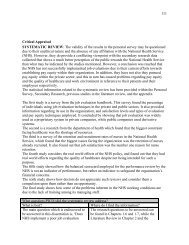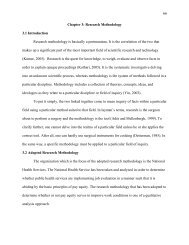13 Chapter 2: Critical Literature Review 2.1 ... - Dissertation
13 Chapter 2: Critical Literature Review 2.1 ... - Dissertation
13 Chapter 2: Critical Literature Review 2.1 ... - Dissertation
You also want an ePaper? Increase the reach of your titles
YUMPU automatically turns print PDFs into web optimized ePapers that Google loves.
38is experiencing one of the worst shortage of nurses in its history. The survey found a fall of 26percent in qualified nurses between 1990 and 1998. Additonal information from the surveyshowed that the biggest issues facing the organization involve the retention of nurses who havealready been recruited (Newman, Maylor and Chansarkar, 2002).According to Humphrey and Ehrich,when they studied the real-world implications of thepolicies set by the National Health Service, they found that the policies of the National HealthService directly impacted human resource management and had a direct effect on the standard ofcare despite not being intended for such a purpose. The article also stated that the long-termeffects of such policies are vague due to effects detailed previously (2003).A survey by Newman, Maylor and Chansarkar found that the Health Service hadconsiderable difficulties retaining nurses of Grade D and E. Grade D refers to those nurses whoare responsible for direct care and Grade E nurses are considered as replacements for Grade Gnurses as well as providing direct care. Grade E is considered senior to Grade D. Reasoningsbehind the fall in rentention included but were not limited to longer working hours, heavyworkloads, staff shortages, inability to finish work at the end of shifts, overtime work notrewarded, lack of funds for training, vacancies not being filled, and a fostering of a culture wherenurses pay for their own training. The survey further found that job satisfaction was the numberone reason for retention among nurses with job characteristics and personal motivations takingsubsequent places (Newman, Maylor and Chansarkar, 2002).Another study on the methods employed by the National Health Service to benchmark itsvarious institutions found that the main method used by the NHS to guage performance was abalanced scorecard. This balanced scorecard not only acted as an indicator of performance, butalso provided a framework for future financial growth (Chang, 2007).





